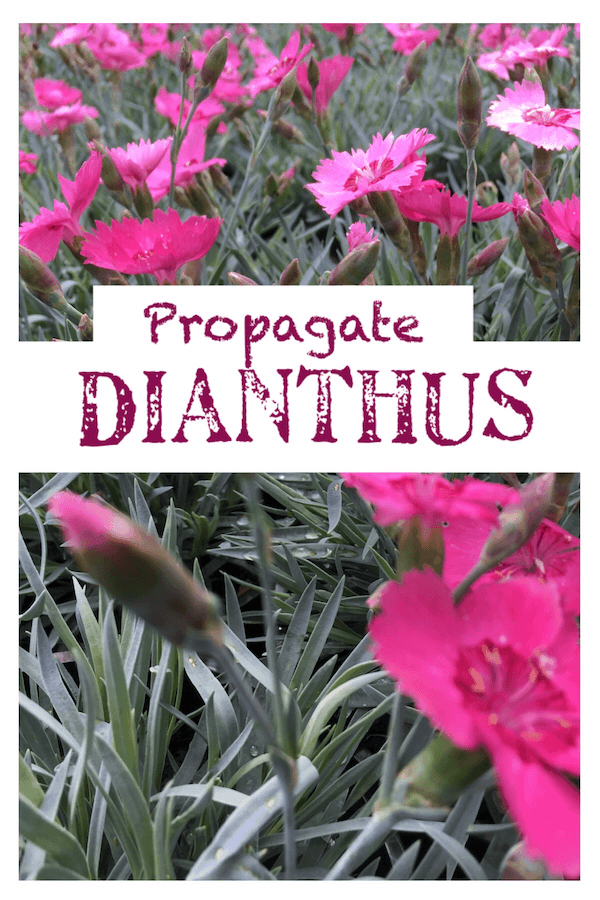
How to propagate dianthus by cuttings
This article will detail how we propagate dianthus using cuttings. We only propagate perennial dianthus using cuttings as the annual varieties are mostly propagated via seed.
Dianthus are a very popular garden plant. We often use them to form a border, as a ground cover or in rockeries. Dianthus are commonly known as Carnation, Pinks and Sweet William.There are over 300 species of dianthus this method will work on them all.
Propagation by cuttings is very easy and is best carried out in early spring. Whilst this is the best time they can be propagated throughout the year. The cuttings in this article were taken in early spring. Roots had struck within 6 weeks and after potting into potting mix they were ready for outside planting within a further 4 weeks.
Cuttings taken in winter will take longer to strike roots. Cuttings taken during flowering will need their flowers removed and success rates may not be as strong.
We had an almost 100% success rate on these cuttings.
Taking the cuttings
When selecting a plant to take cuttings ensure it’s healthy, a cutting is essentially a clone of the parent plant. Its also a good idea to sterilise your secateurs to avoid any unwanted bacteria contamination.
The part of the dianthus we use to create a cutting is the tip. We prefer to use small cuttings approximately 5-7cm(2-3″) in length. Small cuttings are advantageous in that there is less stem and foliage to maintain. A larger cutting is much more likely to stress before the roots develop.
We find that our smaller cuttings will develop roots faster and therefore quickly out perform larger cuttings.
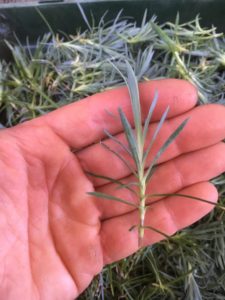
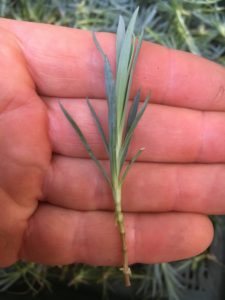
Once you have your cutting you’ll need to remove the lower half of the foliage. This needs to be done quite gently as these tip cuttings can break relatively easy. Simply strip the lower half of the leaves away from the stem (see above pictures).
Striking the roots
To strike the roots we use our mix of perlite and peat moss. The mix is 10% peat moss and 90% perlite, both are exceptional at holding moisture.
We mix up the propagation mix and place it in a seedling tray. Before we insert the cuttings into the mix we lightly water the mix to give it some firmness, this will help hold the cuttings in place.
To insert the cuttings into the mix we lightly carved a straight line and then using a small bamboo skewer we create a small hole and insert the cutting in.
Dianthus cuttings strike very easily there is no need to add a rooting hormone or other rooting agent before inserting into the propagation mix.
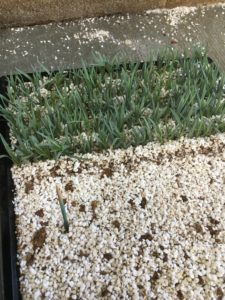
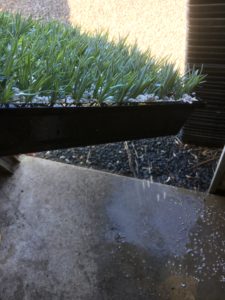
Once all the cuttings have been inserted into the mix, thoroughly water. We ensure this first water is really saturated making sure water runs freely out the seedling trays drainage holes.
Whilst waiting for the cuttings to strike roots they must be kept moist and out of direct sunlight and wind. Direct sunlight and wind will quickly dry out the cuttings and with no roots they will almost certainly not survive.
We store our cuttings in the green house however before we had a greenhouse we kept the cuttings on our back porch. This provided adequate cover from direct light and shelter from the wind.
The roots on these cuttings had struck within 6 weeks. Remember to keep them moist during this time.
Potting the cuttings
Once the roots have struck the cuttings can be potted into soil. We always use a good quality potting mix when potting our new plants. Ensure plenty of organic materials, trace elements and good water retention capabilities.
We pot our cuttings into small 50mm(2″) pots. Because we take hundreds of cuttings this allows us to fit many plants into a relatively small area. Another advantage is that the small pot provides an adequate root system but a nice small hole when planting into the garden.
When the cuttings are potted we like to water thoroughly with a seasol solution. We really find this helps establish a strong healthy roots system in a shorter timeframe.
After watering the freshly potted dianthus should one again return to a sheltered area. Once the roots are developed and the plant is actively growing they can be planted outside into the garden.
One month after potting into our potting mix these cuttings had a root system filling the pot and had at least doubled in size.
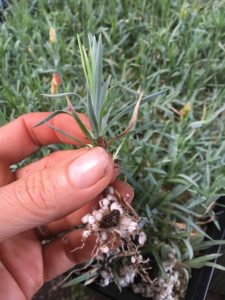
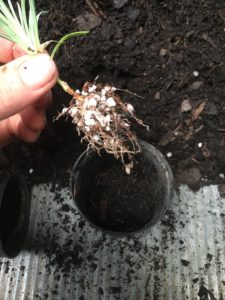
That’s how we propagate dianthus using cuttings. We do hope this article had been helpful and would love it if you subscribe. Happy Planting 🙂
Below is a short little video showing the above steps.
Click here to see more plants we propagate
Propagation Kit
We have also put together a resource page that contains links to the products we use or similar. If you want to check that out click the link.
Propagate Dianthus Video
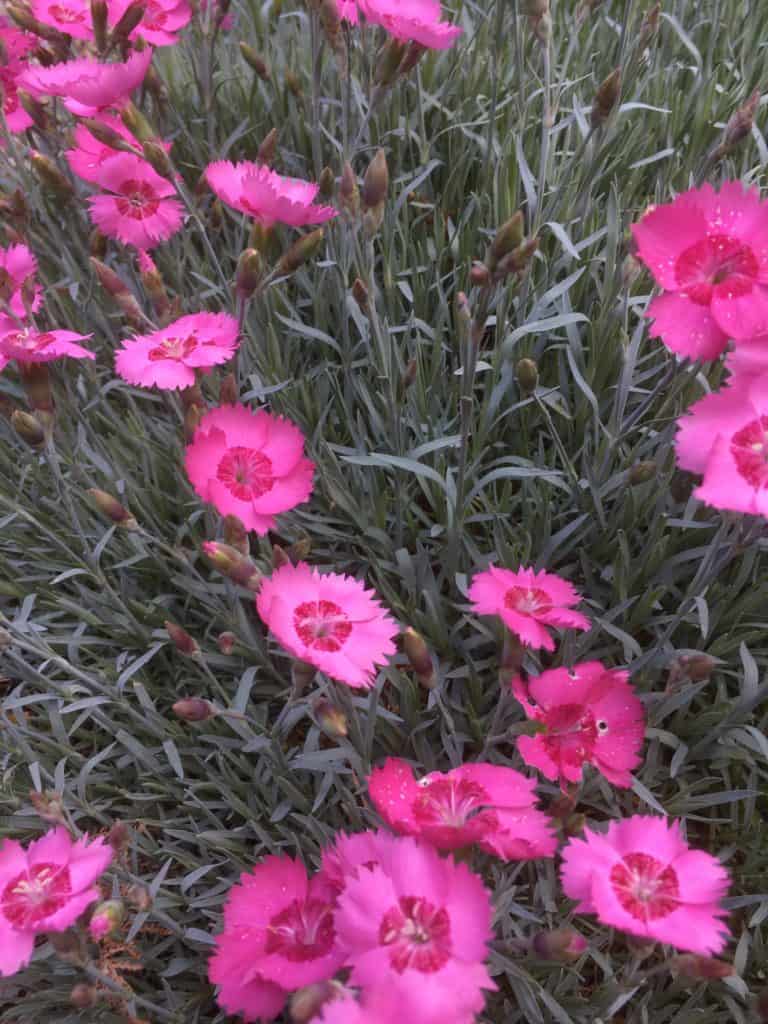
Dianthus Information
Dianthus is a very popular perennial plant with over 300 species in cultivation. It forms tufts of blue-grey sometimes green foliage. Sometimes the plants will stay very low to the ground with flower spikes barly stretching 10cm above the foliage, whilst others are quite leggy and are used as cut flowers.
The flowers are known for the highly spicy sweet fragrance. Dianthus will flower for the majority of the year from mid spring right into autumn. They are a great addition to any mixed flower bed, rockeries or flowery borders.
Dianthus perform best in a full sum position. The prefer soil that is moist but well draining, so not waterlogged. Dianthus will benefit from a feeding of dolomite once a year.
CULTURAL NOTES
Botanical name: Dianthus species
Common name: Carnation, Pink, Sweet William
Family: Caryophyllaceae
Native to: Predominantly Europe & Asia
Flowers: spring-autumn
Position: Full sun
Height: 10cm-90cm
Width: 15cm-1m
